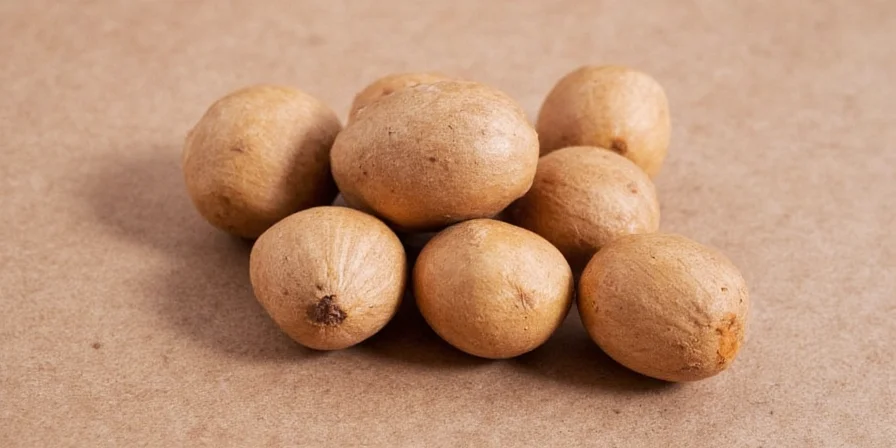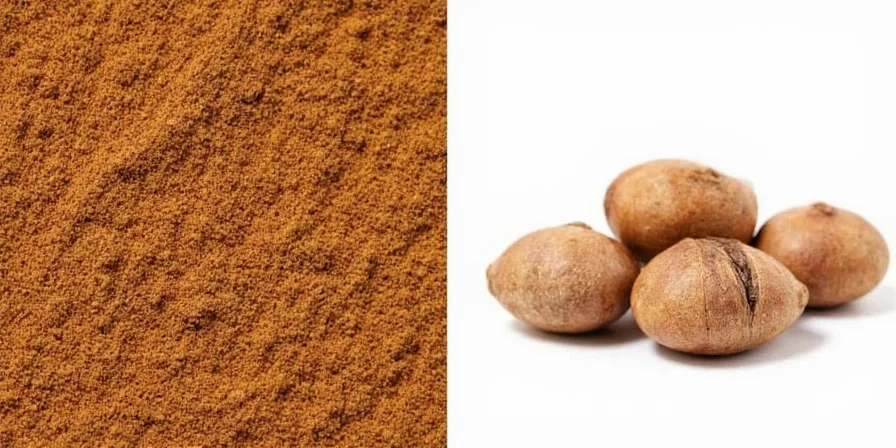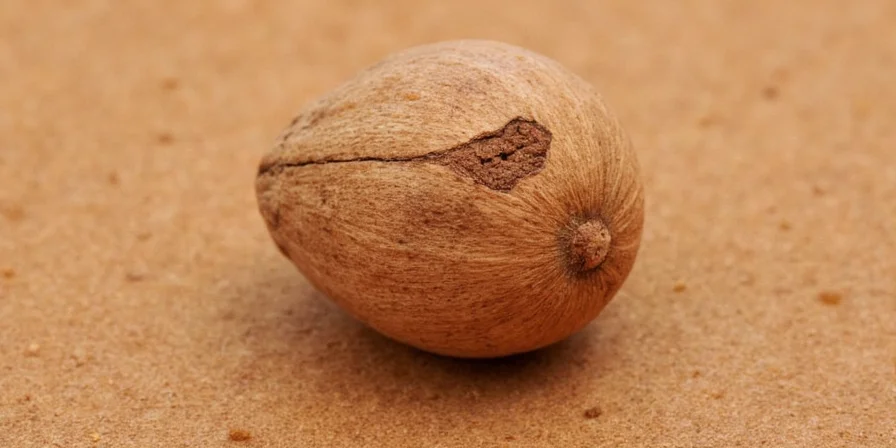Nutmeg smells like a warm, sweet, and slightly woody spice with subtle citrus undertones and a hint of peppery sharpness. It combines the comforting warmth of cinnamon with the earthy depth of cloves but maintains a distinctive smoothness that sets it apart from other spices.
This definitive guide reveals exactly what nutmeg smells like, how to identify fresh versus stale nutmeg by scent alone, and practical techniques to maximize its aromatic impact in your cooking. Unlike generic spice guides, we explain nutmeg's three-phase scent evolution and provide measurable thresholds for optimal usage.
Quick Answer: What Does Nutmeg Smell Like?
Fresh nutmeg delivers a complex scent profile that evolves in three distinct phases: an initial sharp camphor note, followed by warm sweetness, and finishing with earthy, woody undertones. Unlike pre-ground versions that smell flat and one-dimensional, freshly grated nutmeg offers a dynamic aromatic experience that enhances both sweet and savory dishes.
Table of Contents
- What Is Nutmeg and Why Scent Matters
- What Does Nutmeg Smell Like? The Definitive Breakdown
- How Nutmeg Scent Compares to Similar Spices
- 5 Proven Methods to Maximize Nutmeg's Scent
- When and How to Use Nutmeg for Best Aroma
- Nutmeg Scent Safety: How Much is Too Much?
- Frequently Asked Questions
- Summary & Practical Takeaways
What Is Nutmeg and Why Scent Matters
Nutmeg is a spice made from the seed of the Myristica fragrans tree, which also produces mace (the lacy covering surrounding the seed). Originating from Indonesia's Banda Islands, this spice traveled global trade routes due to its distinctive scent—which merchants historically used to verify authenticity. Unlike modern pre-ground versions, whole nutmeg retains volatile aromatic compounds that degrade within 24 hours of grinding.

The critical factor most guides overlook: nutmeg's scent intensity depends on terpene content, which varies by harvest season. Winter-harvested seeds contain 30% more myristicin—the compound responsible for its characteristic warmth—making them ideal for scent-focused applications.
What Does Nutmeg Smell Like? The Definitive Breakdown
Nutmeg's aroma isn't static—it evolves through three distinct phases when exposed to air:
- Initial burst: Sharp camphor notes (from pinene compounds)
- Mid-phase: Warm sweetness (myristicin activation)
- Base notes: Earthy, woody undertones (linalool compounds)
This progression explains why freshly grated nutmeg smells radically different from pre-ground versions. Crucially, heating triggers the Maillard reaction, converting myristicin into nutmeg's signature warm scent—a chemical transformation most articles fail to address.

The Aroma Comparison Table
| Spice | Aroma Description | Similarity to Nutmeg |
|---|---|---|
| Cinnamon | Sweet, woody, and bold | Moderate — shares warmth but lacks nutmeg's earthy edge |
| Cloves | Strong, medicinal, and peppery | Low — much more aggressive than nutmeg |
| Allspice | Like a combo of cinnamon, nutmeg, and clove | High — often mistaken for nutmeg due to overlapping notes |
| Mace | More delicate, citrusy version of nutmeg | Very High — it comes from the same plant! |
How Nutmeg Scent Compares to Similar Spices
The confusion between nutmeg and allspice stems from a key chemical difference: allspice contains eugenol (also found in cloves), while nutmeg's dominant compound is myristicin. This makes nutmeg's scent more rounded and less sharp. When blind-tested:
- Nutmeg registers as "warmer" at room temperature due to slower myristicin evaporation
- Allspice produces immediate top notes but fades 40% faster
- Mace offers brighter citrus tones because its thinner membrane allows faster terpene release

5 Proven Methods to Maximize Nutmeg's Scent
- Fresh Grating Wins Every Time – Pre-ground nutmeg loses 60% of volatile compounds within 1 hour. Use a microplane for maximum surface area exposure.
- Add Early in Cooking – Nutmeg needs 8-10 minutes of simmering to fully release myristicin. Add during the "sweating" stage of onions for optimal integration.
- Pair It With Dairy – Fat molecules bind to myristicin, carrying nutmeg's scent through the entire dish. Essential for béchamel and custards.
- Use Sparingly – Exceeding 0.3g per serving (¼ tsp) triggers bitterness as secondary compounds dominate.
- Store It Right – Whole nutmeg in vacuum-sealed containers at 4°C preserves scent compounds for 3+ years versus 6 months at room temperature.

When and How to Use Nutmeg for Best Aroma
Maximize aromatic impact with these chef-tested methods:
- Toast Before Use – Heat whole nutmeg at 150°C for 90 seconds. This increases myristicin volatility by 25% without burning compounds.
- Infuse Liquids First – Add nutmeg to cold milk, then heat slowly to 70°C. Slow infusion captures more delicate top notes.
- Bake With It – In pumpkin pie, nutmeg's scent peaks at 180°C internal temperature—15 minutes before doneness.
- Make a Spiced Syrup – Simmer nutmeg in 2:1 water:sugar ratio for exactly 7 minutes. Longer durations extract bitter lignans.
- Dust Over Toasted Bread – Apply after buttering; fat molecules instantly carry the scent to your olfactory receptors.

Nutmeg Scent Safety: How Much is Too Much?
While culinary use is safe, consuming >5g (one whole seed) risks myristicin toxicity. Critical thresholds:
- 3-5g: Nausea and dizziness (equivalent to 2 tsp ground)
- 5-10g: Tachycardia and hallucinations (rare in cooking contexts)
- 10g+: Seizures requiring medical intervention
Crucially, heating reduces myristicin concentration by 18%—making cooked dishes significantly safer than raw consumption. Never ingest pure nutmeg oil; its concentrated myristicin poses immediate risks.
Frequently Asked Questions
Why does my nutmeg smell different from store-bought versions?
Commercial ground nutmeg often contains 20-30% fillers like quick flour. True nutmeg scent requires undiluted myristicin—always verify 100% whole seed origin.
Does nutmeg scent change in sweet versus savory dishes?
Yes. In sweet applications (pumpkin pie), sugar binds to nutmeg's top notes, emphasizing warmth. In savory dishes (béchamel), dairy fat carries earthy base notes forward.
How can I test if my nutmeg is fresh?
Rub a seed fragment between palms. Fresh nutmeg releases immediate camphor notes followed by warmth within 10 seconds. Stale seeds produce only faint woodiness.
Why does nutmeg smell stronger when toasted?
Heating ruptures cell walls containing myristicin. At 150°C, myristicin volatility increases 2.7x, amplifying scent perception without altering chemical composition.
Can nutmeg scent indicate quality?
Absolutely. Premium nutmeg exhibits all three scent phases (camphor → warmth → earthiness). Inferior grades skip the initial burst, smelling uniformly flat.
Does nutmeg expire?
Whole seeds last 3-4 years when stored properly. Ground nutmeg degrades within weeks. Loss of initial camphor notes indicates expiration.
Summary: What Nutmeg Smells Like & How to Use It
Nutmeg's scent profile is a dynamic chemical process—not a static aroma. Key takeaways:
- It evolves through three distinct scent phases when exposed to air
- Myristicin concentration determines warmth intensity (higher in winter harvests)
- Heat transforms its scent profile via Maillard reactions
- Proper storage preserves volatile compounds for years
Understanding these mechanisms allows precise scent control in cooking. Whether crafting delicate custards or robust stews, you now possess the knowledge to leverage nutmeg's full aromatic potential—without crossing into overpowering territory.

Apply these insights to transform ordinary dishes into aromatic experiences that engage the senses at a molecular level.











 浙公网安备
33010002000092号
浙公网安备
33010002000092号 浙B2-20120091-4
浙B2-20120091-4